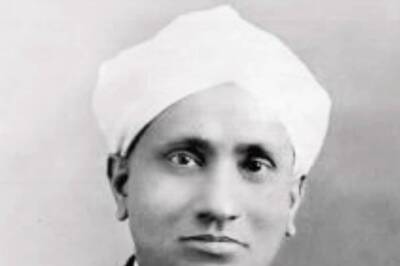
views
With just over a week to go for the G20 Summit in Delhi, Piyush Goyal, Union Minister for Commerce and Industry, Consumer Affairs, Food and Public Distribution, spoke to Network18 Group Consulting Editor Nalin Mehta on India’s digital revolution, its evolution and the implications of the growth of digital public infrastructure such as UPI and direct benefit transfers (DBT) to the poor and India’s emerging Techade.
Edited excerpts:
Q: The word ‘Techade’ is something which Prime Minister Narendra Modi has been talking about for two years now. It means different things to different people. You have said in the past that we have now reached a new dimension in our digital economy. What does this idea of an Indian ‘Techade’ mean to you?
In digital payments and digital public goods, we have become the talk of the world. When I think of India’s Techade and why the honourable Prime Minister coined this word, I think of what I call India’s 30-30-30 matrix.
In the next 30 years, India will add $30 trillion to our economy. I personally believe it will happen in the next 24 years. And we will be at a $35 trillion economy by 2047. We are at $3.75 trillion today. It’s the largest opportunity today anywhere in the world. At no time in history has any nation seen this kind of an opportunity — where you grow from 3.5 trillion to 35 trillion in less than three decades.
The second element is our population, which at one point of time used to be a bane. The world recognises it to be a boom today. As the Prime Minister enunciated in his August 15 address this year, we largely have an under-30 population. This is our demographic dividend.
The third element is that for the next 30 years, our average age is going to continue to be below 30.
That’s what I call the 30:30:30 matrix.
All of this rests on the foundation of our digital world. The fact that today we produce more STEM graduates than any other country in the world, that we are already the third-largest start-up ecosystem, that a young man coming from Odisha can create a multibillion-dollar company in less than five-six years – is a story that we used to hear can only happen in the US.
Our young population today is driven with fire in their belly. There are zero starvation deaths in India. We’ve reached a stage where the fire in the belly is not for food. The fight is for the good things in life. And where does that fire come from? The digital world.
The nooks and corners of the country today are connected digitally. I dare say we have a better 4G network than the United States today. We have about 6,500 railway stations where Wi-Fi is available in the country.
Our rollout on 5G is amongst the fastest in the world. We will have 125 cities connected to 5G in around less than a year. We have already embarked on 6G development, which only three other countries in the world are doing.
This digital revolution, bringing down the cost of data to probably the lowest in the world today, this fast expansion throughout the country where 900 million people have an internet connection which means almost every youngster is on a smartphone — is key.
Digital technologies are connecting the country, driving desire and ambition. That’s what’s going to drive India to greater growth levels. That’s why it is India’s Techade.
Q: Digital technologies have also changed the relationship between the state and the poor. The cabinet has recently approved Rs 14,900 crore for Digital India. But what we’re talking about is much more than that by itself. In terms of the poor, the growth of DBT has changed politics as we know it. Can you talk a little bit about that?
The honourable PM spoke about 10 crore fake beneficiaries recently. The 10 crore non-existent people have been weeded out, thanks to technology.
We don’t ever hesitate to recognise that Nandan Nilekani, the illustrious co-founder of Infosys, developed the Aadhaar concept much before we came into government. It was much misunderstood.
With due respect, please don’t take it as politicising but sadly, they [the previous government] were not able to understand and appreciate the huge potential of Aadhaar. When Nandan came out with it, they were not able to appreciate the huge potential of the interoperable systems that ultimately became UPI. And now we are using it for Open Networks for Digital Commerce so that e-commerce also can be socialised.
Sadly, they [UPA government] were not able to visualise its full potential and cash in on the benefits. There was also an element of a little bit of political grandstanding because two senior ministers had certain differing views. One wanted a National Population Register, another was promoting Aadhaar and in the process, the country suffered a delay.
In 2014, Prime Minister Narendra Modi came into the government and invited Nandan Nilekani to present to him what Aadhaar was about. Can Aadhaar invade your privacy? Does Aadhaar cause the kind of disruption that we all thought it did in our own way? We were all mistaken. Because it was not explained well enough to us. But it was the Prime Minister’s vision that changed things.
After understanding the issue and going into deep detail, he asked RS Sharma, who was involved in that process, and Nandan to talk to some of his colleagues in the Cabinet.
He visualised that for financial inclusion to be successful, the first basic need was to empower people with a bank account.
Originally, the Jan Dhan accounts were meant to deliver the Mudra loans. The idea was that the poorest of the poor should have an eligibility to draw bank loan at affordable prices, but then Aadhaar came along and gave us a second opportunity.
The mobile world was expanding simultaneously. That is where JAM (Jan Dhan-Aadhaar-Mobile) came into being. It has been transformational in its impact in terms of the government’s delivery of welfare, with DBT.
It started during the UPA’s time. As Nirmala Sitharaman ji pointed out during her address in the no-confidence motion, there were barely a few thousand transactions using this trinity when we came into the government. Look at the transformation from there to where we are today. Nearly 30 lakh crore has been disbursed through the JAM, directly into the bank accounts of the people of India: Rs 2.5 lakh crore have been transferred to the farmers’ bank accounts under the Pradhan Mantri Kisan Samman Nidhi Yojana. Four crore poor families got a free home.
Overall, Rs 30 lakh crore has been dispersed to the poor (since 2014). An earlier Prime Minister had said ‘if I disburse Rs 100 to the poor, only Rs 15 reaches them’. If we had to give our Rs 30 lakh crore in that earlier system with 15% reaching the poor or the beneficiaries, as a chartered accountant, I can tell you we would have had to disperse Rs 200 lakh crore of public money and effectively, Rs 170 lakh crore would have otherwise been lost in the system.
That’s the difference which technology has made to India. That’s why DBT has been not only a game changer for India, but I promise you in the next few years, this is going to be a game changer for the entire world.
Today, this backend protocol that Nandan has developed has become the base not only for UPI, but also ONDC. Imagine that in the nine years of working in the field, there has not been one occasion of leakage, not one occasion that it has been a source of misuse.
Q: We’ve seen how UPI exploded in ways that nobody imagined. Tell us about ONDC (Open Network for Digital Commerce), where it is going and what are the challenges in that?
I just had a chat with Adil Zainulbhai, who was also actively involved in ONDC. We raised Rs 180 crore in our first round of fund-raising, on one video conference. We sent some briefing notes to 14-15 potential investors. There was one video call where the officials explained what they had conceptualised as ONDC. We now have cash in the bank. ONDC has already touched about 100,000 transactions a day. But I still call it a beta-testing phase. Not a small mean achievement.
People ask me ONDC is meant for the small retailers, so why are you taking on Amazon or Flipkart? Why are Tatas, Birlas, Airtel and Reliance also on ONDC? It is because I believe if I have to socialise ONDC and make it a success, we need big and small all to coexist. That will give a choice to consumers. My largest stakeholder is India’s 140 crore consumers.
Q: There has also been the issue around restrictions on imports of laptops and computers. There is a fear that you’re bringing back the licence-permit raj. How would you respond to that critique?
I am absolutely open to any dialogue, any discussions. I’m happy to have the industry come and meet with me if required. But generally, all these discussions have been held by my colleague who’s heading the Information Technology Ministry. They’ve gone through all the stakeholder consultations. We are very confident, given the capacity and the surplus capacity not yet utilised, there will be no disruption in the availability or the price. Should a situation like that occur, we are a listening government, not a government that is not accessible. We’ll be ready to engage with industry and look at other options also.
But it is a serious security matter and it’s not about any of the things that some of the press has been speculating. Please don’t speculate. I can only share with you even a Tesla car is not allowed anywhere near when Xi Jinping is present because they are very conscious of the risks to security. Even from a car being present in the vicinity of the Premier of China. India also has to protect itself from countries who are antagonistic to India. We have to protect ourselves, our leaders, our businesses.
Piyush Goyal spoke to Nalin Mehta, at the launch of his book, India’s Techade: Digital Revolution and Change in the World’s Largest Democracy. Mehta is the Dean of School of Modern Media at UPES University in Dehradun, a Non-Resident Senior Fellow, Institute of South Asian Studies at the National University Singapore, and Group Consulting Editor, Network 18.




















Comments
0 comment